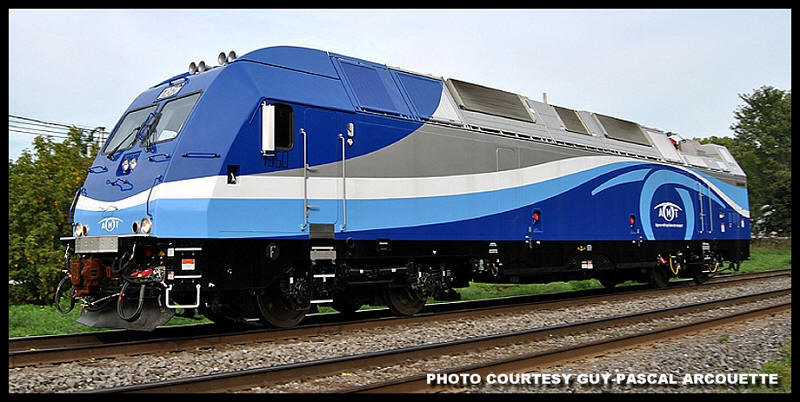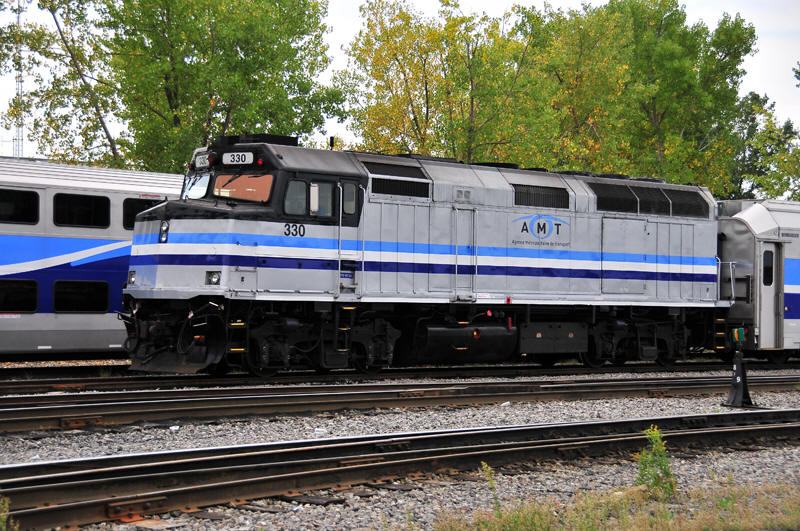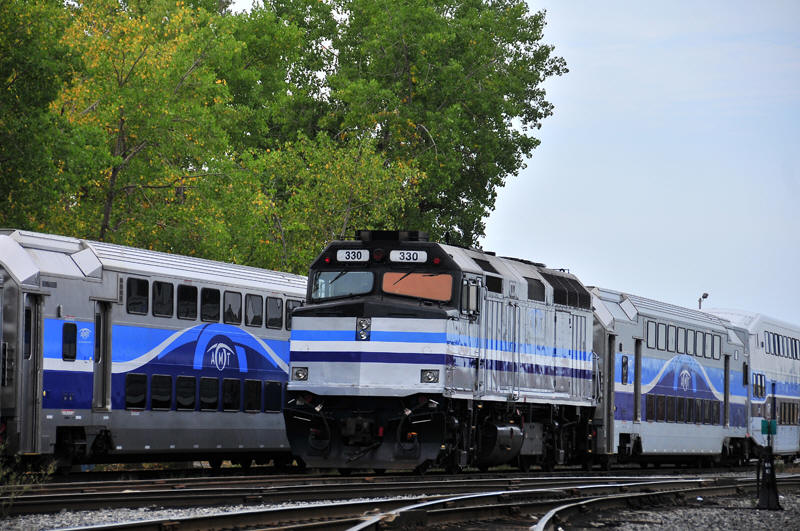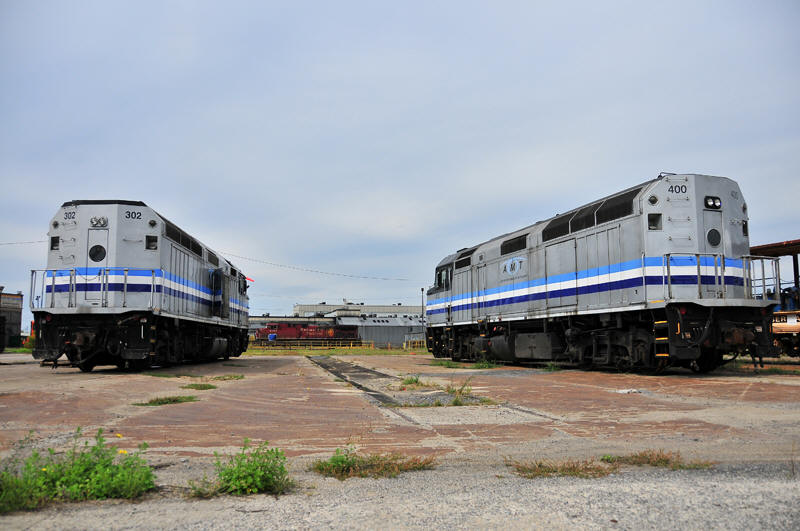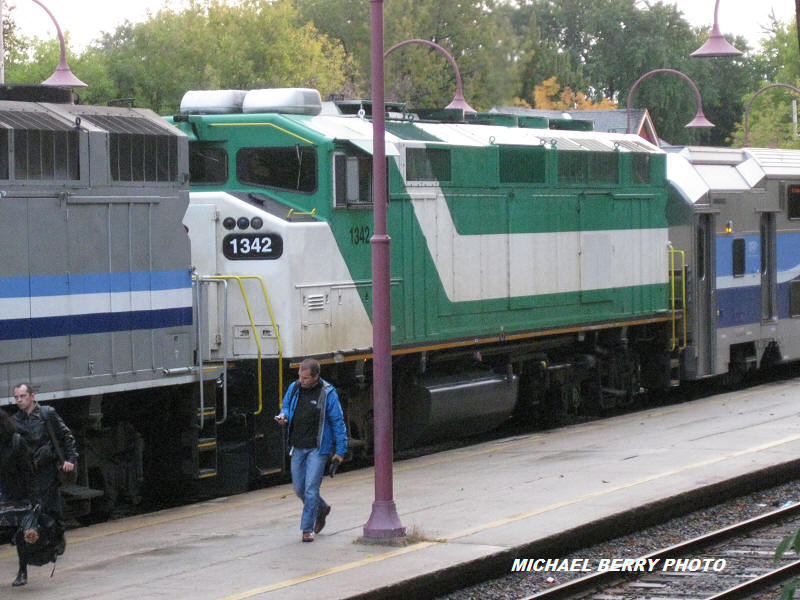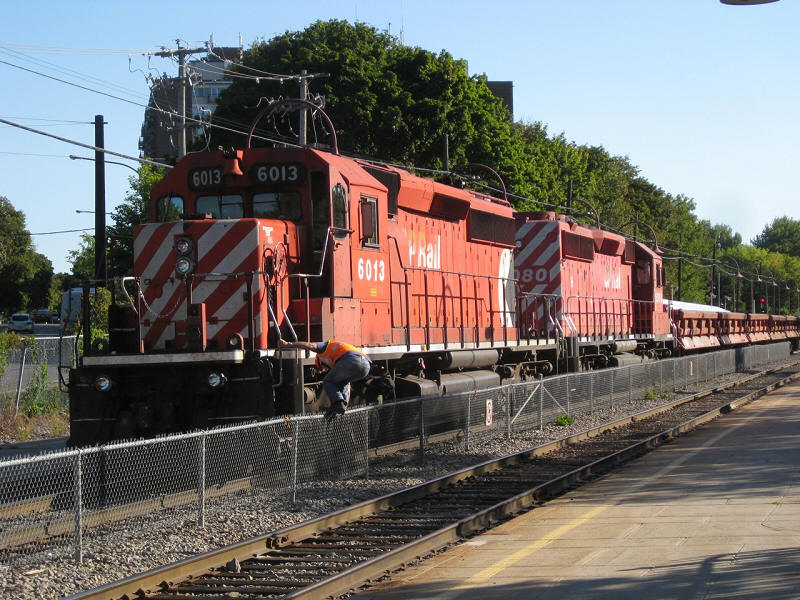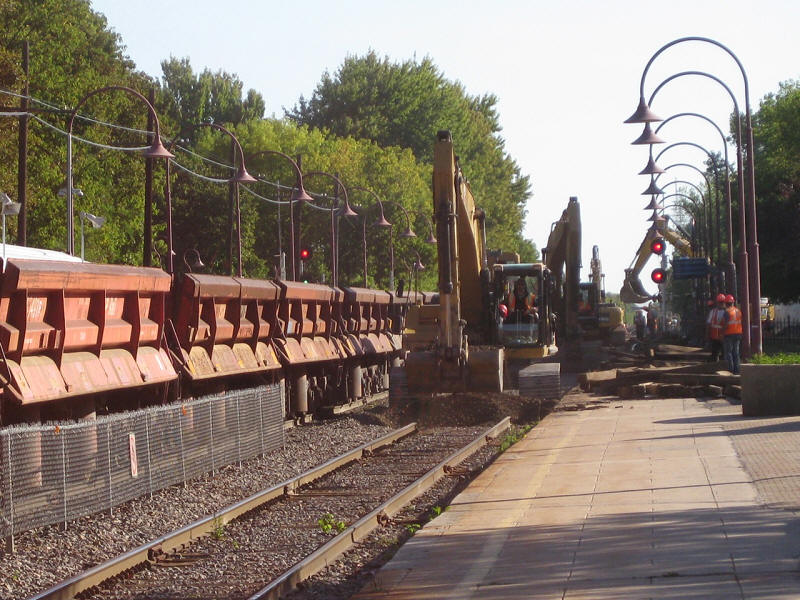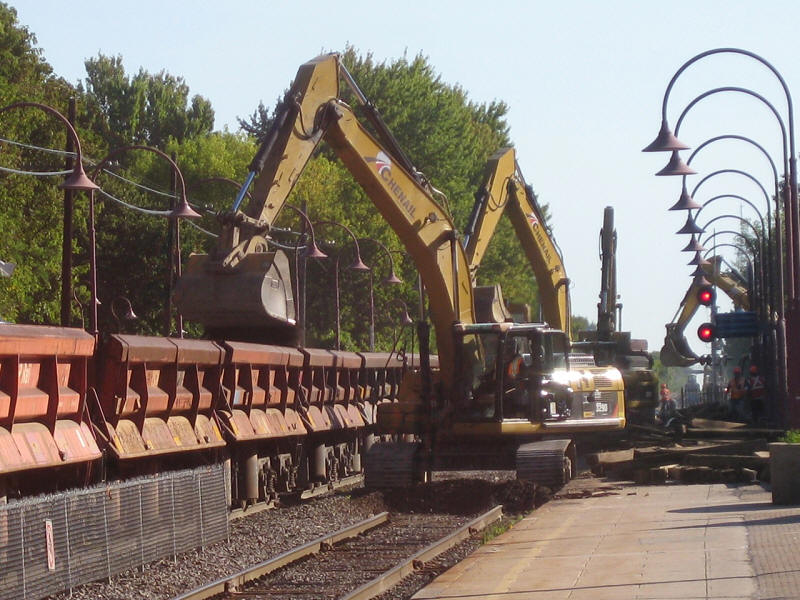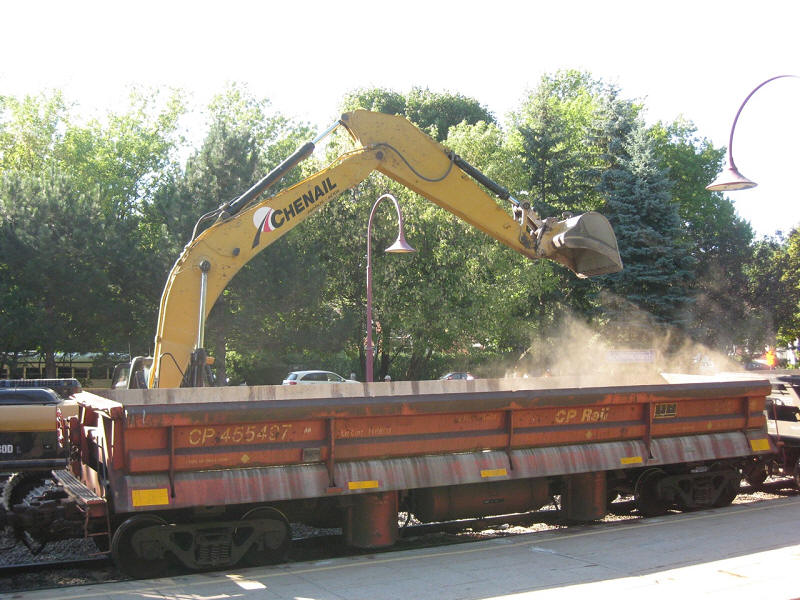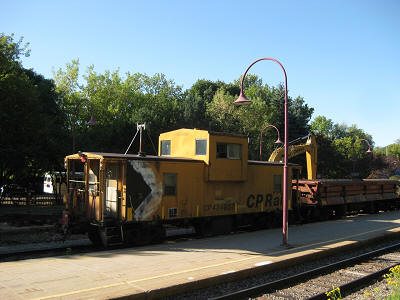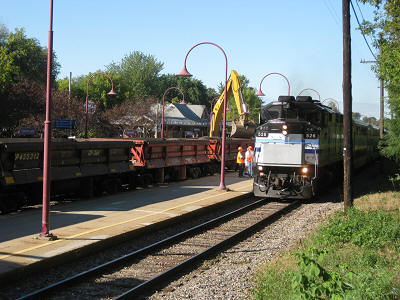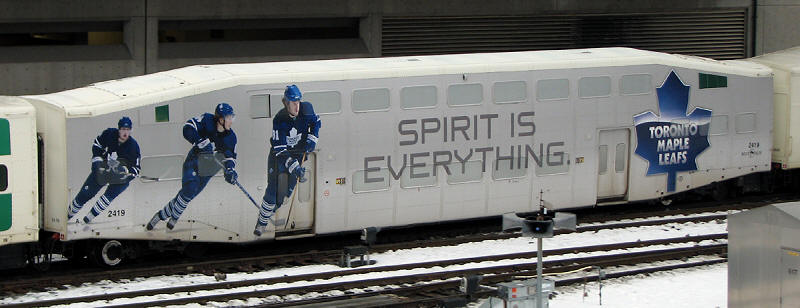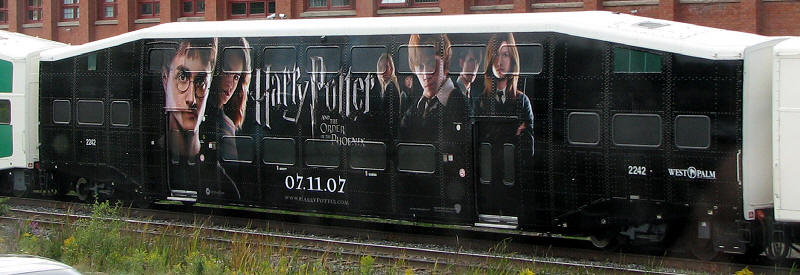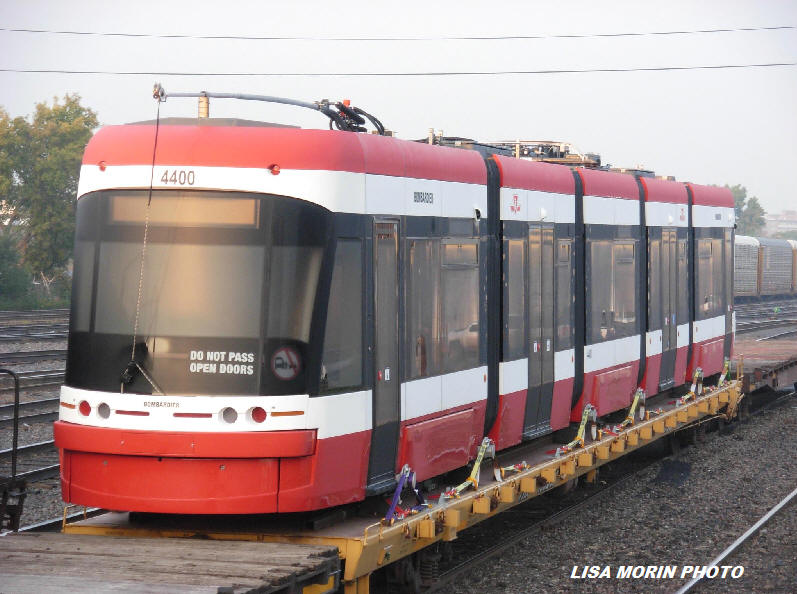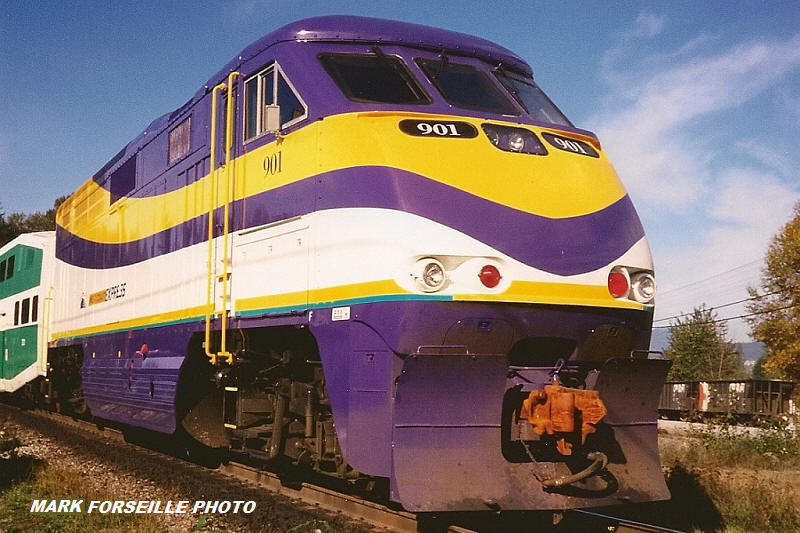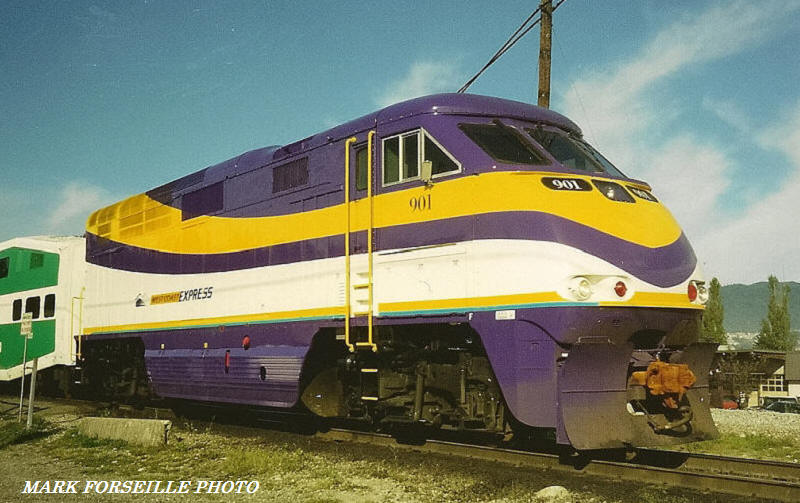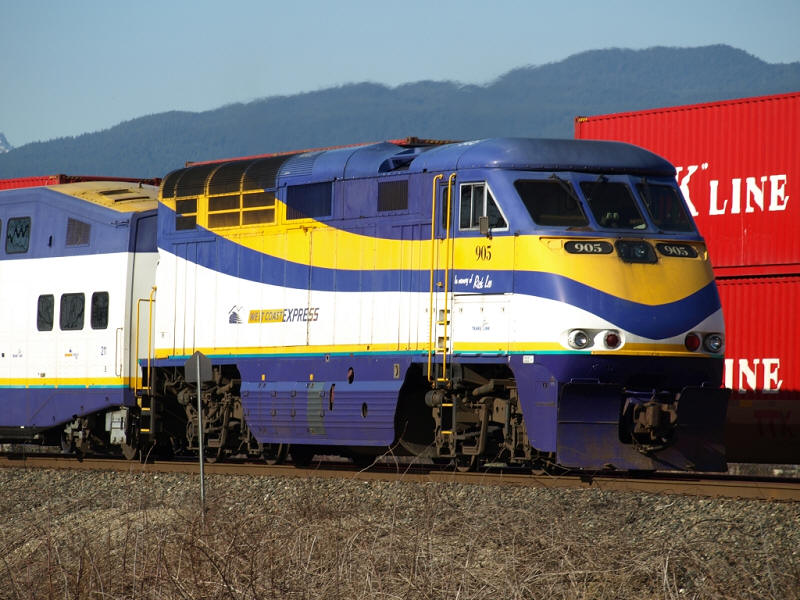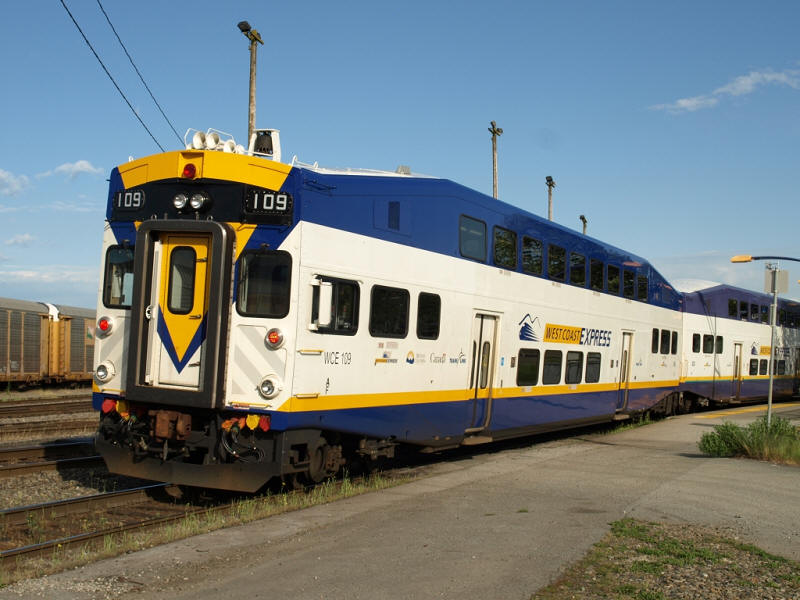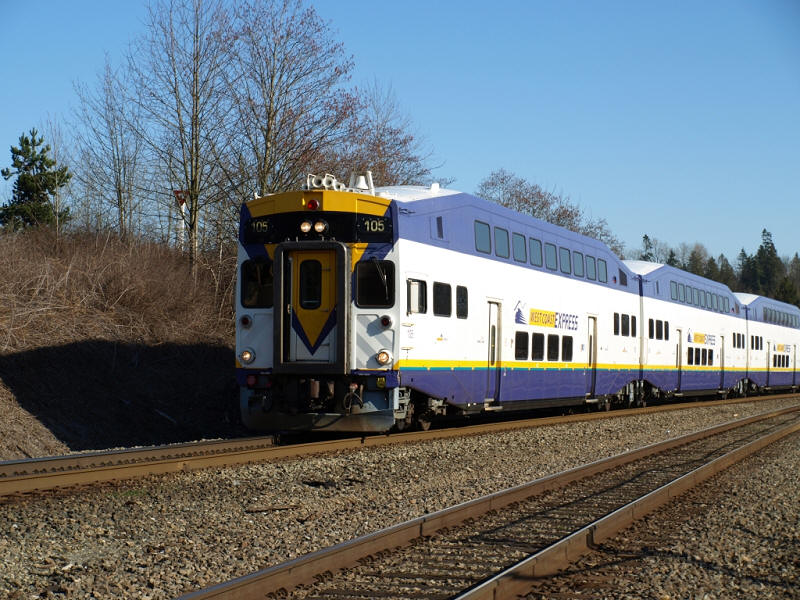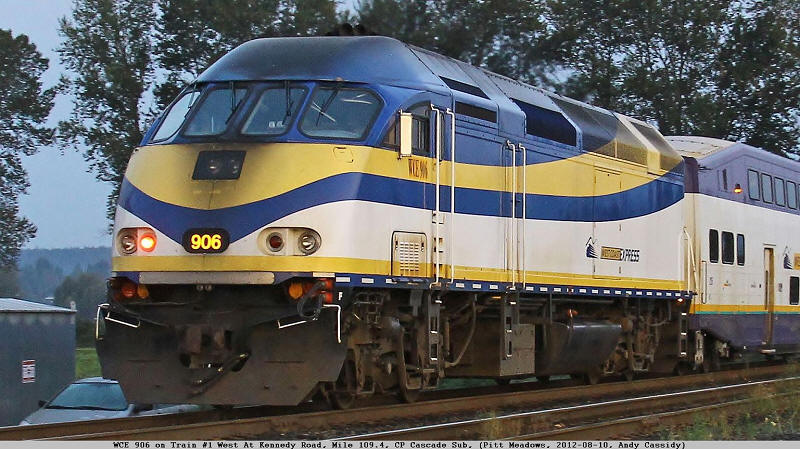AMT COMMUTER/GO TRANSIT/WEST COAST EXPRESSAMT Agence Metropolitaine de Transport AMT News Editor Jean-Francois Turcotteamtnews@canadianrailwayobservations.com
AMT ALP-45DP Watch: CN is banning the locomotives from leading a train until the derailment investigation is completed by the Transportation Safety Board of Canada, following the 1352ís derailment at Central Station on December 9th 2011. Although the investigation is still in progress, a likely cause for the derailment, although not confirmed, has been hinted to be the inability of Central Stationís tracks to withstand the excessive forces on the rail exerted by the extra-powerful ALP45DPís. AMT and CN are reviewing a wide range of options to allow the high-tech dual mode locomotives in service as soon as possible. One of the locomotives (AMT 1350) was moved to AMP Pointe St-Charles Shop and was moved over CN with special CN Superintendantís permission. It is still unknown when these may be called to active duty. The ALP45-DP locomotive fleet has been in storage ever since the first one placed into service (AMT 1352) derailed in December 2011 pulling into Central Station. The AMT locomotives were purchased at a total cost of $308 million to allow the Agence Mťtropolitaine de Transport to increase service, particularly on the overcrowded Deux Montagnes commuter line The AMT bought 20 of the German-built Bombardier locomotives. The dual-mode (diesel and electric) locomotive are to be used on the Deux Montagnes commuter line, which serves Laval and the North Shore and s the AMT's only electric-powered line. The agency has said it needs the new locomotives before it can start using new double-decker railcars on the line. Those double-deckers have up to 30% more capacity than typical single-level cars. The locomotive derailed on tracks owned by CN. The TVA network quoted an internal study commissioned by the AMT and CN that indicated CN tracks at Central Station may have been defective and could not support the new locomotive, which is more powerful than others in the AMT fleet. AMT spokesperson Brigitte Lťonard said the AMT has hired an external engineering firm to provide "a range of possible solutions" that would allow the locomotives to be put back on track. TSBC spokesperson John Cottreau said the board's investigation is in progress. He could not say when it would be completed. On average, it takes the agency 16 months to complete rail investigations.
In revenue service: NIL
AMT 1350 Tested near Pointe St-Charles Yard in mid-September 2012 AMT 1351 Stored in St-Eustache since mid-February. AMT 1352 Removed from service following derailment. AMT 1353 Stored in St-Eustache after some testing in May. AMT 1354 In storage following testing. AMT 1355 In storage following testing. AMT 1356 Stored in Ste-Eustache since early January. AMT 1357 Stored in St-Eustache since mid-February. AMT 1358 Stored in St-Eustache since mid-February. AMT 1359 Stored in Ste- Eustache since early January. AMT 1360 Stored in St-Eustache since mid-February. AMT 1361 Stored in St-Eustache since late-February. AMT 1362 Arrived in St-Eustache on April 8th AMT 1363 Arrived in St-Eustache on April 8th AMT 1364 Arrived on property Date unknown AMT 1365 Arrived on property Date unknown AMT 1366 Arrived on the property May 14th AMT 1367 Arrived on the property May 14th AMT 1368 Arrived on property Date unknown AMT 1369 Arrived on property Date unknown
(As of June 25th, 2012 the entire AMT ALP-45DP fleet had been delivered by Bombardier). Nicolas Houde and William Baird visited St-Luc Yard on September 7th and clicked F40PHís 400 and 302 around the turntable, and 33o on the ready tracks.
The ten AMXX F59PHís 1340, 1341, 1342, 1343, 1344, 1345, 1346, 1347, 1348 and 1349 that AMT has purchased are stored at American Motive Power (Pointe St-Charles Yard), until they can be prepared for Montreal Commuter service. AMXX 1341 being load tested at the St-Luc Roundhouse on August 29th . AMT 1342 was trailing AMT 526 on train 77 to Candiac. Michael Berry photographed her on September 26th as it passed through Montreal West Station at 6:05 September 27th.
AMT is currently receiving tender submissions for the mid-life overhaul of this group of F59PH, with units 1340, 1343, 1346, 1347, 1348 and 1349 to be overhauled first. Units 1341, 1342, 1344 and 1345 will be put in service as quickly as possible, following conversion of their HEP voltage from 575V to standard 480V. On September 1st, two CP SD40-2's (CP 6013 and CP 6080) were at Montreal West Station with a rip rap train. CP caboose CP 434957 was on the rear. The southernmost track in front of the station and the ballast underneath was being torn up. Elmhurst Avenue was also closed and the lakeshore trains were using the north junction track.
AMT electrification plans shelved AMT has pulled the plug on its mid-term plan to electrify part of its network, owing to landlords CN and CPís unwillingness to allow such installation on their tracks. CN spokesperson Louis-Antoine Paquin is arguing that electrification would induce unacceptable gauge restriction, would hinder CNís ability to route traffic effectively under catenaries, as well as producing interference between high-voltage power lines and CNís traffic control system. Such claims are somewhat surprising, considering that US Class I Norfolk Southern and CSX Transportation routinely operate doublestack container trains under SEPTA catenaries near Philadelphia. Photo Link: http://www.railpictures.net/viewphoto.php?id=356175 Photo Link: http://www.railpictures.net/viewphoto.php?id=353113 SEPTA catenaries allows AAR Plate F cars to safely operate under. Allowing higher cars (AAR Plate G or extra-high dimensional shipments) would simply require the catenaries to be deployed higher, which would have been unavoidable in any case, owing to the extra height of AMTís Bilevel cars (2000-series) and F59PHIís (#1320-1330). Moreover, CN also operates train L56421 under catenaries on the Deux-Montagnes line to reach its isolated Doney spur, as well as over the double diamond at Jct de líEst (although it is being replaced by a grade separation). And finally, a fully functional CTC has been operating on the Deux-Montagnes electric line since 1995. CN and CPís rebuttal are a serious blow to the MinistŤre des Transports du Quťbecís strategy, which calls for electrification of 95% of the mass transit network by 2030. In the latest election, all of Quebecís major political parties openly supported electrification of the commuter rail network in partnership with Hydro-Quebec, and the idea reaches a broad consensus among Quebecís population. Observers call for AMT to actively pursue acquisition of rail lines from CN and CP to circumvent the freight carriersí reluctance to embrace electrification, citing Torontoís Metrolinx as an example. However, while CN is a minor tenant on Metrolinx-owned trackage, AMT operates on main lines heavily used by CN and CP (most notably the St-Hilaire and Vaudreuil lines), so having the carriers selling those vital pieces of trackage is even more unlikely. The end result is that AMTís ALP45DPís fleet, already side-tracked, may never live up to its full potential because AMT had ordered them specifically for the phased electrification of its network, which will now not happen any time soon, if ever. Five ALP45DPís will operate as dual-modes on the Mascouche line, and three more as pure electric units on the Deux-Montagnes line. The extra twelve units will operate in pure diesel mode, which would not be so tragic had they not each costed three times the price of an average passenger diesel locomotive. Read Andy Rigaís story in The Gazette GPS System available to passengers coming soon AMT is making real-time information about train locations available to programmers, who could use the data for creating websites and smartphone apps for riders. Montreal Gazette reporter Andy Riga is reporting that: - Real time information about AMT trains will be integrated into the trip-planning feature of Google Maps; - Five new Twitter feeds will be created to provide updates on tardy trains Ė one for each of AMTís five train lines. Link to full story: here AMT Plans a $40-million upgrade of the Mount Royal Tunnel Montreal Gazette reporter Andy Riga reports that AMT has earmarked at least up to 40 million dollars to improve the safety feature of the Mount Royal tunnel, in order to allow the safe passage of diesel-laden dual mode locomotives starting in 2013 when the Mascouche line is opened. The 1918-built tunnelís lack of ventilation and safety exits has drawn a lot of criticism by several elected officials, although the tunnel has routinely hosted diesel-powered trains until 1995, without anybody apparently minding back then. In the mean time, AMT intends to deploy the dual-mode locomotives on the Deux-Montagnes line as soon as CN clears them for service, since they will operate in pure electric mode, without any significant amount of diesel fuel on board. Same story from Railway Age AMT eyeing new rail line on Champlain Bridge La Presse reporter Bruno Bisson is reporting that AMT intends building a new rail line to the South Shore over the new Champlain Bridge, which is expected to open in 2021, replacing the existing structure built in 1962. The Champlain Bridge is currently hosting a heavily used bus lane, operating against the current-of-traffic during peak hours. This bus lane is currently running at capacity, carrying up to 20000 riders per peak period. With demand expected to rise at 35000 riders per peak by 2021, AMT states that a light or heavy rail line is the only viable option to offer proper mass transit between Downtown Montreal and the South Shore community of Brossard. AMT had previously explored a light rail line on running the ice boom parallel to the Champlain bridge. This project would have proved technically challenging, since the ice boom doesnít cross the seaway, requiring a new high-span and strong-graded bridge. Now that Champlain Bridge is stated for replacement, integrating the rail line on the new bridge may prove far simpler.
On August 15th, GO Transit announced they are having 11 MP40PH-3Cís rebuilt with
Cummings engines (Indiana) to be delivered in 2015. They currently have EMD
710G3-T2 16-Cylinder engines but in an effort to to reduce emissions (in part
due to a push by local residents in some corridors facing increased GO service)
GO will have eleven MP40PH-3Cís converted and re-engined with twin Cummins QSK60
Tier 4 emissions compliant engines. Initially, they were going to receive
Cummins' new 4000hp QSK-95, but since that's not ready, twin QSK-60's will be
substituted in order to meet emissions requirements. The prototype, GO 647 will
be converted for testing at MPI in Boise, Idaho for testing in 2013. The other
10 will follow in 2014 and 2015, constructed from Kits at GO Willowbrook Shop.
The latest new GO bilevels in transit (older deliveries likely in service on GO
by now): Ontario will receive more than $94 million from the federal government to help bolster the province's commuter rail line east of Toronto. Federal Finance Minister Jim Flaherty and Ontario Transportation Minister Bob Chiarelli announced the funding this morning in Whitby, ON. They say the private-public funding will go towards the construction of a maintenance facility for GO Transit trains, which serve the Greater Toronto Area and the Golden Horseshoe. Flaherty says the funding is a big win for commuters and will give GO an opportunity to provide even better service in the GTA. Over the years, GO Transit has "wrapped" a number of its passenger cars with full-body advertising wraps for various companies, agencies, shows, movies, and organizations. Here are a few variations on the theme: GO 2419 wrapped for local NHL hockey team the Toronto Maple Leafs, arriving on an eastbound train at Union Station, January 2009.
Movies and TV shows also make appearances on GO cars, like GO 2242 wrapped for Harry Potter and the Order of the Phoenix, on Georgetown line train 207 at Brampton, September 2007.
Another movie car, 2206 is seen departing on Lakeshore West train 919 with a wrap for the upcoming Speed Racer movie, April 2008.
GO Bilevels 2421 and 2401 wrapped for grocery chain Metro, on Stouffville line train 864 heading to Union Station in February 2009. Most of the time when multiple cars are wrapped, they are separated and go into service on multiple trains. The odd time however, two of the same are kept on the same train.
HOT! TTC 4400, the first of TTC's new articulated streetcars from Bombardier in
Thunder Bay ON, enroute to the TTC for delivery. It is in transit on TTIX
flatcar 156393, noted at CPR's Lambton/West Toronto Yards in late September
2012.
On September 15th, a closure of the Spadina line caused havoc with morning and afternoon commuters for half the day. In the wee hours of the morning when track maintenance was going on, a work train struck two maintenance workers at track level, resulting in one fatality. This tragic incident occurred along the Spadina line south of Wilson Yard, which is the TTC's main facility for dispatching trains on the Yonge-University-Spadina line. As a result of an extensive investigation that followed and closing the line in the area, trains could not depart Wilson Yard to serve the YUS for the morning rush hours. There was no subway service between Downsview and Lawrence West Stations, and the remaining portion of the Yonge-University-Spadina line had to be run with the few trains that were stored at Davisville, as well as trains that were transferred from the Bloor-Danforth line (Greenwood Yard) to the YUS to boost service. Additionally, shuttle buses were running along the entire line to help alleviate some of the overcrowding. The investigation was wrapped up just after noon and normal subway service resumed on the entire line. The results of this investigation have not been announced yet.
By Mark Forseille Please forward any WCE News items and photo to dmarkforseille@telus.net The West Coast Express runs between Mission, BC (MP 87.0 CP Cascade Sub) and Vancouver's Waterfront Station (MP 129.1 CP Cascade Sub Monday to Friday. There are five trains that travel West from Mission in the morning and the five trains return to Mission in the Evening.
The West Coast Express has a fleet of six locomotives: Five GMD F59PHI's purchased in 1995. They are numbered #901 to #905. One MPI MP36PH-3C purchased in 2006 and numbered #906. The WCE has a total fleet of 44 passenger cars all of which were built by Bombardier. They consist of 9 Bi Level cab control cars that seat between 142 and 144 passengers. #101 to #108 were purchased back in 1995. #109 was purchased in 2010 The WCE has 5 146 seat Bi Level coaches with "Expresso" coffee bars. They are numbered #201 to #205 and were all purchased back in 1995 and 1996. The WCE also has 30 more 148 seat Bi Level coaches. The first 15 were purchased back in 1995 #206 to #220. Nine more were purchased in 2000/2001 #301 to #309. Six additional coaches were purchased in 2010. Numbers #401 to #406. Note that the 406 is equipped with an "Expresso" coffee bar like the #201 to #206 series. (** The WCE roster information with thanks is from the 2012 Canadian Trackside Guide). For further information and schedules please check out the West Coast Express link http://tripplanning.translink.ca/hiwire?.a=iScheduleLookupSearch&LineName=997&LineAbbr=997
WCE F59PHI 901 is seen at MacAulay MP 112.4 of the CP Cascade Sub October 29th, 1995. The West Coast Express service has not yet started and the were still running test runs with GO Transit Coaches.
WCEX F59PHI 901 is seen at Port Coquitlam, BC on Oct 19th, 1995
An action photo of Cab Control car WCE #105 at the lead just starting to slow down to stop at the Port Haney station at MP 102 of CP's Cascade Sub. The headlights and ditchlights are clearly visible in this photo. One more shot of many that I managed to take during the 2010 Winter Olympic Games held in Vancouver during February that year.
One of the newest coaches on the West Coast Express fleet is Cab Control Car #109 bringing up the rear at the Port Coquitlam station taken just a few months ago in May 2012.
The WCE 905 is headed East at Pitt River MP 108 on CP's Cascade Sub back in Feb 2010 operating expanded service during the Vancouver 2010 Olympic Games. This was a great time to catch extra trains in good light since I was off work waiting for my knee surgery at the time. WCE is the current recording marks for the West Coast Express since and is now stencilled on their units replacing WCEX.
On August 10th, Andy Cassidy decided to catch the morning Westbound WCE trains as they passed by Kennedy Road out at VIF, Mile 109.4 on the CP Cascade Sub. Train #1 came by just after 0600 hrs, and the only way to get decent shots is during the longer days of summer. As it was, it was almost too dark to catch a decent shot of Train #1. I had to crank the ISO up to 1000 on the first shots to get a decent shutter speed. Even then I could only go to 1/125 sec. WCE 906 on Train #1 West At Kennedy Road, Mile 109.4, CP Cascade Sub.
Please forward any WCE News items and photo to dmarkforseille@telus.net ©CRO October 2012 |

